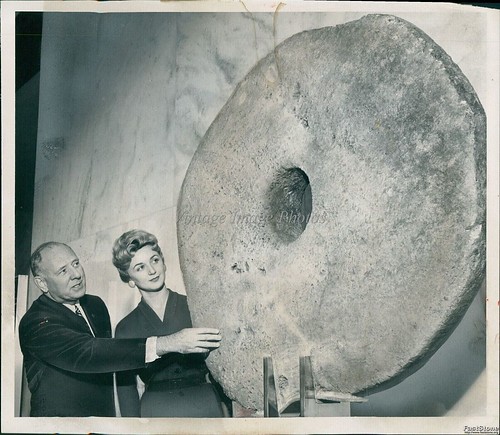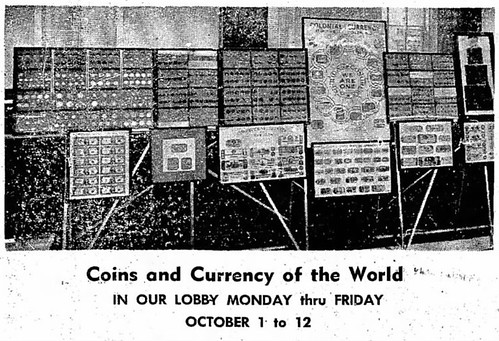
PREV ARTICLE
NEXT ARTICLE
FULL ISSUE
PREV FULL ISSUE
NUMISMATIC EXHIBITIONS AT U.S. BANKSE-Sylum Feature Writer and American Numismatic Biographies author Pete Smith submitted this article on Numismatic Exhibitions at U.S. Banks. Thanks! -Editor
Bank Exhibitions
I realized this week that I had written several articles about coin exhibitions at banks. I also realized how common these have been. This week I will offer a review and some additional comments. Coin clubs have often presented coin exhibits for banks during National Coin Week. I offer someone else the opportunity to catalog those. I would not be surprised it there have been more than a thousand.
Bank Money Museums
The Federal Reserve Bank has had money museums in their branches in Atlanta, Chicago, Cleveland, Denver, Jacksonville, Kansas City, Miami, Richmond, Saint Louis, and San Francisco at various times. The Chase Manhattan Bank opened their Money Museum at the Chase Bank in 1929 and was later installed at Rockefeller Center until it closed in 1973. They acquired the collection of Farran Zerbe who stayed with the collection as curator. Later curators included Vernon Brown and Gene Hessler. This was the most popular money museum in the United States. The Mercantile Bank of St. Louis had the Mercantile Money Museum housing items from the collection of Eric P. Newman. They also had a portion of his library available for study. The Museum of the Money of the American West was formerly the Bank of California Gold Rush Museum. It is now hosted by the Union Bank. The National Bank of Detroit Money Museum featured the collection of Nate S. Shapiro. It opened April 28, 1960, and closed in 1992. Oscar K. Dodson was the first curator, succeeded by Charles Hoskins. It was noted for a large piece of Yap stone money. The National Bank of Logansport Indiana had a money museum created by the Logansport Coin Club. It opened April 9, 1971, and is now gone. The N. A. S. C. Money Museum was created by the Numismatic Association of Southern California. It was initially at the Union Bank in Los Angeles in 1967. It was moved to the Coast Federal Savings and Loan in 1973, and to the Airport Century bank in 1975. The Union Planters National Bank Money Museum in Memphis featured the collection of P. B. Trotter, a bank vice president. It opened May 1, 1969. It appears the museum was closed by the time Potter died in 1981. There is often promotional hype when a museum opens but less publicity when it closes. There are also bank museums that feature the building and the banking business. Some of these may have numismatic content. Wells Fargo recently closed museums in branch banks leaving only the museum in San Francisco.
Travelling Exhibits
Banks have frequently promoted coin exhibits at their banks without naming the owner of the collection. It can be understood that most donors would prefer anonymity while a few prefer self-promotion. Branches of the Federal Reserve Bank have also offered travelling exhibits for local banks. The Federal Reserve Bank of Philadelphia did not have a money museum, but did offer a travelling exhibit. The Alabama Bankers Association funded a travelling exhibit shown hundreds of times in the state between 1953 and 1977. The Chase Bank also put the museum on tour at local banks. Catalogs for these exhibits would provide a challenging collecting theme. Louis Eliasberg put his collection on display at the United States Mint in Philadelphia for the Bicentennial in 1976. He also exhibited at banks in Baltimore, MD, 1950, Chicago, IL, 1956, Philadelphia, PA, 1957, and Richmond, VA, 1958.
Cyrus Phillips, Hal Proskey (son of David) offered an exhibit of biblical coins at a New York bank in 1954. Oscar G. Schilke offered his travelling exhibit more than a dozen times in New England during 1952 to 1960. He took advantage of the opportunity to buy from the public. As an ANA district secretary, he helped form local clubs, signed up new ANA members and attended many shows in the region. William F. Sneed, Jr. was a famous numismatist and promoter most frequently seen in Florida. He was most active during 1951 to 1958. His photograph was prominently displayed in the ads. The ads looked like they were placed by Sneed and the bank location was only incidental. In addition to banks, he showed his collection at local department stores. Coins from the collection of J. W. Wohlenberger were displayed in the window of the Golden State National Bank in 1922. This was mentioned only once.
Zerbe
Farran Zerbe was the most famous American numismatist in the early years of the twentieth century. He exhibited his famous collection at World’s Fairs and Expositions as well as at local banks before the collection was acquired by the Chase Bank. I know there are people in the ANA who had disputes with him. However, among the general public, more people during his lifetime would have known his name than the name of the then-current ANA President.
Phillips, Schilke and Snead
I accept that each of these might qualify as a
Today
I suspect the most famous American numismatists today have shows on late night TV. They are not showing widow’s mites and Swedish plate money. Rather they are promoting MS-70 silver eagles. Most of their customers do not belong to a local club, have never been to a coin show and do not receive the weekly E-Sylum. I do not consider their influence on the hobby to be positive. Great list. I was unaware of some of these, and am particularly impressed by the zeal of Cyrus Phillips. Perhaps these showcase opportunities still exist if local collectors and organizations were to pursue them. With the transition away from cash many bank branches are less transactional and more about marketing services to new and existing customers. Maybe a presentation and exhibit about coins and money would be welcomed as a way to draw in potential customers. -Editor
To read earlier E-Sylum articles, see:
Wayne Homren, Editor The Numismatic Bibliomania Society is a non-profit organization promoting numismatic literature. See our web site at coinbooks.org. To submit items for publication in The E-Sylum, write to the Editor at this address: whomren@gmail.com To subscribe go to: https://my.binhost.com/lists/listinfo/esylum All Rights Reserved. NBS Home Page Contact the NBS webmaster 
|





